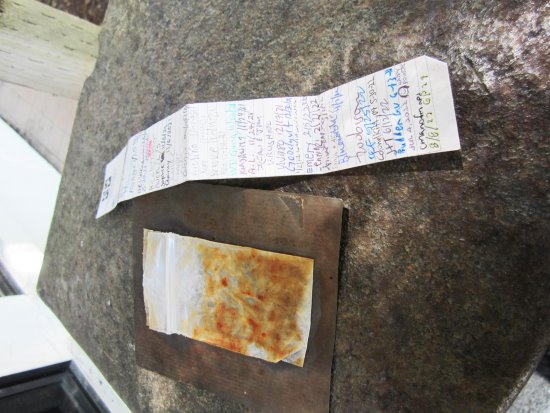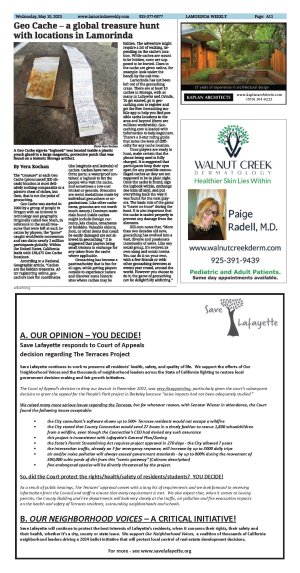| | Published May 10th, 2023
| Geo Cache - a global treasure hunt with locations in Lamorinda
| | | By Vera Kochan |  | | A Geo Cache sign-in "logbook" was located inside a plastic pouch glued to a large magnetic, protective patch that was found on a historic Moraga artifact. Photo Vera Kochan |
The "treasure" at each Geo Cache (pronounced JEE-oh-cash) location is most definitely nothing comparable to a pirate's chest of riches, but then, that is not the point of geocaching.
 Geo Cache was started in 2000 by a group of people in Oregon with an interest in technology and geography. Originally called Geo Stash, in reference to the small treasures that were left at each location by players, the "game" caught worldwide momentum and can claim nearly 2 million participants globally. Within the United States, California leads with 138,475 Geo Cache locations.
Geo Cache was started in 2000 by a group of people in Oregon with an interest in technology and geography. Originally called Geo Stash, in reference to the small treasures that were left at each location by players, the "game" caught worldwide momentum and can claim nearly 2 million participants globally. Within the United States, California leads with 138,475 Geo Cache locations.
 According to a National Geographic article, "Caches are the hidden treasures. After registering online, geocachers look for coordinates (the longitude and latitude) of caches. Caches have two or three parts: a waterproof container, a logbook to list the people who visit the cache, and sometimes a low-cost trinket or geocoin. (Geocoins are metal medallions made by individual geocachers or organizations. Like other cache items, geocoins are not worth much money.) Common materials found inside caches might include foreign currency, key chains, ornaments or booklets. Valuable objects, food, or other items that could be easily damaged are not allowed in geocaching." It is suggested that players bring small trinkets to exchange for any taken from the cache where applicable.
According to a National Geographic article, "Caches are the hidden treasures. After registering online, geocachers look for coordinates (the longitude and latitude) of caches. Caches have two or three parts: a waterproof container, a logbook to list the people who visit the cache, and sometimes a low-cost trinket or geocoin. (Geocoins are metal medallions made by individual geocachers or organizations. Like other cache items, geocoins are not worth much money.) Common materials found inside caches might include foreign currency, key chains, ornaments or booklets. Valuable objects, food, or other items that could be easily damaged are not allowed in geocaching." It is suggested that players bring small trinkets to exchange for any taken from the cache where applicable.
 Geocaching has become a pastime/hobby that is fun for all ages, while getting players outside to experience nature and discover some historic sites where caches may be hidden. The adventure might require a bit of walking, depending on the cache's location. While caches are meant to be hidden, none are supposed to be buried. Clues to the cache are given online, for example: look under the bench by the oak tree.
Geocaching has become a pastime/hobby that is fun for all ages, while getting players outside to experience nature and discover some historic sites where caches may be hidden. The adventure might require a bit of walking, depending on the cache's location. While caches are meant to be hidden, none are supposed to be buried. Clues to the cache are given online, for example: look under the bench by the oak tree.
 Lamorinda has not been left out of the geocaching craze. There are at least 10 caches in Moraga, with as many in Lafayette and Orinda. To get started, go to geocaching.com to register and get the free Geocaching mobile app to help you find possible cache locations in the area and beyond (there are millions worldwide). Geocaching.com is loaded with information to help beginners. There's a 5-star rating guide that notes the level of difficulty for any cache location.
Lamorinda has not been left out of the geocaching craze. There are at least 10 caches in Moraga, with as many in Lafayette and Orinda. To get started, go to geocaching.com to register and get the free Geocaching mobile app to help you find possible cache locations in the area and beyond (there are millions worldwide). Geocaching.com is loaded with information to help beginners. There's a 5-star rating guide that notes the level of difficulty for any cache location.
 Once players are ready to hunt, make certain that the phone being used is fully charged. It is suggested that participants keep their eyes open for any possible camouflaged caches as they are not supposed to be in plain sight. Once the cache is found, sign the logbook within, exchange one item (if any), and put everything back the way it was found for the next players. The basic rule of the game is "Leave no trace" during the hunt. It is also important that the cache is sealed properly to prevent any damage from the elements.
Once players are ready to hunt, make certain that the phone being used is fully charged. It is suggested that participants keep their eyes open for any possible camouflaged caches as they are not supposed to be in plain sight. Once the cache is found, sign the logbook within, exchange one item (if any), and put everything back the way it was found for the next players. The basic rule of the game is "Leave no trace" during the hunt. It is also important that the cache is sealed properly to prevent any damage from the elements.
 REI.com notes that, "More than two decades old now, geocaching has evolved into a vast, diverse and passionate community of users. Like any social group, it's evolved its own slang and social norms. You can do it on your own, with a few friends or with other geocaching devotees at events year round, around the world. However you choose to do it, the game of geocaching can be delightfully addicting."
REI.com notes that, "More than two decades old now, geocaching has evolved into a vast, diverse and passionate community of users. Like any social group, it's evolved its own slang and social norms. You can do it on your own, with a few friends or with other geocaching devotees at events year round, around the world. However you choose to do it, the game of geocaching can be delightfully addicting." |
| | | | | | | | | | | | |



